Abstract
The Lower Cretaceous Baxigai Formation is characterized by fan-delta front deposits and serves as a crucial target for ultradeep tight gas exploration in western China. Consequently, investigating its reservoir characteristics and controlling factors is critical. To characterize these reservoirs, we integrated well logs, core observation and analyses, thin-section petrography, high-pressure mercury injection, and scanning electron microscopy. This approach enabled comprehensive analysis of tight reservoir attributes and their genetic controls. Results show that the Baxigai Formation developed a fan-delta system, with premium reservoirs primarily concentrated in subaqueous distributary channels of fan-delta fronts. Reservoir lithology consists of medium- to fine-grained arkose and lithic arkose, exhibiting well-developed intergranular and intragranular dissolution pores alongside low mineralogical maturity. With average porosity of 2.76% and permeability of 0.24 × 10−3 μm2, these reservoirs are classified as low-porosity and medium–low-permeability systems. Depositional, diagenetic, and structural factors are the main controls on reservoir quality. Subaqueous distributary channels and mouth bars within the fan-delta system provide favorable conditions for reservoir development. Intergranular dissolution pores formed by feldspar dissolution and organic acid reactions play a key role in enhancing reservoir quality and supporting hydrocarbon generation. Structural fractures play a pivotal role in elevating permeability and establishing effective fracture–pore configurations.
1. Introduction
Global energy transition necessitates efficient ultradeep gas exploitation; tight gas reservoirs like those in the Kuqa Depression play an increasingly vital role. Located on the northern margin of the Tarim Basin in Xinjiang, the Kuqa Depression serves as the primary gas source for China’s strategic West-to-East Gas Pipeline project and the key hub for reserve growth and production enhancement in the basin [1,2,3,4,5]. In recent years, significant achievements have been made in deep hydrocarbon exploration within the Tarim Basin. Two trillion-cubic-meter scale gas-rich zones have been established in the Kela-Keshen and Bozi–Dabei areas, confirming and expanding the potential of deep to ultradeep formations. To date, 54 gas reservoirs have been discovered in the Kuqa foreland thrust belt, with ultradeep natural gas resources reaching 5.98 × 1012 m3. The Bozi–Dabei zone alone has contributed over 100 billion cubic meters of proved geological reserves in the Baxigai Formation, demonstrating substantial hydrocarbon potential in ultradeep tight reservoirs [6].
Exploration targets for ultradeep hydrocarbons vary across the Kuqa Depression due to distinct geological settings. As the Cretaceous Bashijiqike Formation—the primary producing interval—experiences declining trap resources, exploration has shifted toward deeper, geologically complex strata. In particular, the Lower Cretaceous Baxigai Formation Submember, located beneath the Bashijiqike Formation in the Bozi–Dabei area, has emerged as a key replacement target. However, exploration of this interval faces significant challenges due to intense tectonic deformation, multiphase sedimentary evolution, and complex diagenetic modifications. These factors collectively result in highly intricate reservoir space evolution mechanisms, especially at depths exceeding 6000 m. Frequent interbedding of braided deltaic and marginal lacustrine facies leads to pronounced spatial heterogeneity in lithology and reservoir properties, increasing the difficulty of sweet spot prediction [7,8]. In deep to ultradeep sandstone and conglomerate reservoirs, the evolution of matrix porosity is jointly controlled by compaction, dissolution, and cementation under high-temperature and high-pressure conditions. However, the mechanisms by which these factors interact to form effective reservoirs remain poorly understood [9]. Additionally, multi-origin overpressure—driven by Tianshan Mountain compression and multi-stage source rock maturation—introduces significant uncertainties in hydrocarbon charging, migration, and accumulation models [10,11].
Accurate characterization of the Baxigai Formation’s storage capacity, fracture networks, and fluid enrichment patterns is therefore essential for refining reservoir assessments, optimizing development plans, and enhancing well productivity. This study focuses on the Baxigai member reservoirs in the Bozi–Dabei area through integrated analysis of well logs, core descriptions, casting thin sections, high-pressure mercury intrusion (HPMI), and scanning electron microscopy to decipher the microstructure and genetic controls of the Baxigai Formation. We hope our findings will provide critical insights for efficient exploitation of deep tight gas resources.
2. Regional Geological Setting
The Kuqa Depression covers approximately 28,000 km2 along the northern margin of the Tarim Basin. Its formation directly relates to intense Late Cenozoic thrust–nappe tectonics within the South Tianshan orogenic belt. Bounded by the South Tianshan Orogenic Belt to the north and the Tabei Uplift to the south, the depression developed upon a foundation shaped by Late Hercynian orogenesis. It subsequently experienced multiple phases of tectonic superimposition during the Indosinian, Yanshanian, and Himalayan periods. These tectonic events gave rise to a series of structurally complex units, including the Northern Monocline Belt, the Kelasu Structural Belt, and the Yiqikelike Structural Belt, as well as the Baicheng, Yangxia, and Wushi Depressions, collectively providing favorable conditions for hydrocarbon accumulation [7]. The Kelasu Structural Belt, situated between the Northern Monocline Belt and the Baicheng Depression, is currently one of the most actively explored and hydrocarbon-rich areas in the region. The study area occupies the western margin of the Kelasu belt at the intersection of the South Tianshan thrust system and intra-basin reverse faults, forming a south-dipping foreland thrust belt (Figure 1). The region is characterized by well-developed thrust structures, with three major north-verging thrust faults: Bozi-Kela, Keshen, and Baicheng, striking from north to south. These faults play a key role in shaping the internal structural framework and controlling the distribution of traps within the study area [5,12].
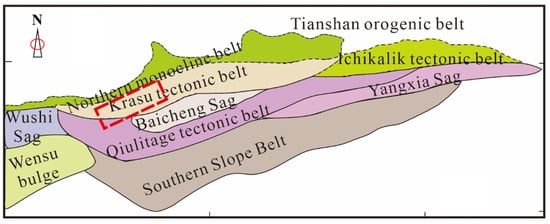
Figure 1.
Structural location in the Bozi–Dabei area of the Kuqa Depression.
The Lower Cretaceous Baxigai Formation is the principal reservoir-bearing succession in the study area, with burial depths ranging from 5500 to 8200 m; it is conformably overlain by the Bashijiqike Formation and consists of gypsum. Deposited under an arid climatic regime, the formation is dominated by prodelta deposits of a fan-delta system. Sediments were primarily sourced from two provenances: the Wensu paleo-uplift and the South Tianshan orogenic belt, with the latter serving as the dominant sediment supply. The formation comprises interbedded medium- to fine-grained quartz sandstones, siltstones, and mudstones, exhibiting significant lateral thickness variations.
3. Sedimentary Facies Characteristics and Distribution
During the Early Cretaceous, the Kuqa Depression represented a shrinking lacustrine basin within the South Tianshan foreland system, with its depositional extent ranging from the Wushen Depression in the west to the Yangxia Depression in the east. The deposition of the Bashijiqike Formation during the Middle Early Cretaceous marks a critical stage in lacustrine basin evolution. Under intensified tectonic compression, a regressive phase prevailed, leading to the widespread development of braided river delta systems. From the Late Cretaceous to Paleogene, stable tectonic conditions facilitated extensive clastic deposition, with the Lower Cretaceous Baxigai Formation serving as the principal interval for deep hydrocarbon source rocks and reservoirs. This unit provides essential material foundations for ultradeep gas accumulation, holding significant exploration value [13].
3.1. Sedimentary Microfacies Characteristics
Typical wells within the Bozi–Dabei area were selected for single-well profile facies and microfacies analysis (Figure 2). Results indicate that the Bashijiqike Formation was deposited in a proximal subaqueous fan-delta front environment. The first member represents a distal fan-delta front subfacies, characterized by four primary microfacies types: mouth bars, sheet sands, subaqueous distributary channels, and interdistributary bays. A distinctive feature is the presence of sand encased in mud. The second member mainly comprises proximal subaqueous distributary channel and interdistributary bay microfacies, consisting of thick gravelly sandstone bodies. Laterally, early-stage fan lobes are more extensive, while late-stage fans display lateral shifting and vertical stacking patterns. Gravel content is higher in the eastern part of the formation, indicative of proximity to main channel axes. With increasing influence of wave reworking, some interdistributary bay sand bodies were transformed into mouth bars and channel sand bodies. Due to incision by subaqueous distributary channels around deltaic islands, the mouth bar sand bodies became isolated and discontinuous along the lakeshore, while channel migration occurred frequently.
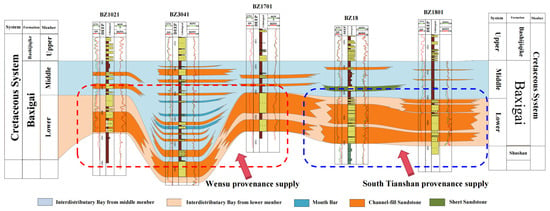
Figure 2.
Sedimentary facies correlation profile of the Baxigai Formation in the Bozi–Dabei area, Kuqa Depression.
3.2. Sediment Provenance Characteristics
The Heavy Mineral Index (HMI) serves as a critical parameter in the analysis of sediment provenance, transport processes, and the evolution of depositional environments. In this study, three standardized indices are applied to the Bozi–Dabei area: the ZTR index, which quantifies provenance maturity and transport history; ATi, which is used to infer source rock lithology; and GZi, which is used to reflect the tectonic setting of the source area [14,15,16,17]. These indices are defined as follows:
where ZTR refers to the combined proportions of zircon, tourmaline, and rutile. Total Transparent Heavy Minerals refers to all identifiable non-opaque heavy minerals (e.g., zircon, tourmaline, rutile, garnet) under polarized light microscopy, excluding opaque minerals like magnetite.
In this context, the Apatite–Titanite Index (ATi) is used to assess the relative abundance of apatite in sediments, which reflects the lithology of the source rock and the degree of chemical weathering. The Garnet–Zircon Index (GZi) serves as a key indicator of garnet abundance in sediments and is commonly used to infer sediment transport distance or weathering intensity.
The composition, abundance ratios, and spatial variation of stable heavy minerals can be used to quantitatively characterize sediment provenance attributes, including source rock type, tectonic setting, transport distance, and evolutionary trends. Figure 3 presents the compositional analysis and comparative results of heavy minerals from the second member of the Baxigai Formation. The green polygons denote samples sourced from the South Tianshan orogenic belt, whereas the blue polygons highlight those supplied by the Wensu provenance. The analysis shows that ZTR values across the study area are generally below 10%, with high proportions of unstable minerals. This suggests a short transport distance and limited sedimentary recycling. Furthermore, the ZTR indices are lower in the southern source areas compared to those in the north. The ATi values are mostly below 30%, with isolated wells showing abnormally high indices. This indicates limited contribution from felsic igneous source rocks in most parts of the study area. GZi values predominantly range from 20% to 50%, reflecting a significant contribution from medium- to low-grade metamorphic source rocks.
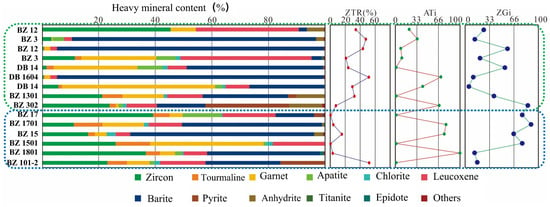
Figure 3.
Compositional comparison of heavy minerals in the study area.
4. Reservoir Characteristics
4.1. Petrological Attributes
Reservoir lithology, identified through thin-section petrography and XRD bulk mineralogy analysis, consists of medium- to fine-grained sandstones interbedded with thin dark brown mudstones [18,19]. Petrographic analysis also reveals that the dominant lithologies are feldspathic sandstone (Type IV) and lithic feldspathic sandstone (Type V) (Figure 4a). The grains are medium- to fine-grained, moderately sorted, and exhibit sub-angular to sub-rounded shapes. Intergranular contacts are primarily linear to concavo-convex. As shown in Figure 4b, results from X-ray diffraction (XRD) and thin-section petrography indicate that quartz is the dominant mineral phase, typically ranging from 35% to 50%, with an average content of approximately 42.3%. Feldspars are mainly represented by plagioclase and K-feldspar, with total contents ranging from 25% to 35%; K-feldspar shows a slight predominance. Lithic fragments account for around 20%, suggesting that the provenance area includes contributions from metamorphic basement rocks. The compositional maturity index (maturity = quartz/[feldspar + lithics]) ranges from 0.5 to 0.9, indicating a reservoir of relatively low mineralogical maturity. The pore-filling cements are primarily composed of calcite and clay minerals. Illite is the dominant clay species, followed by illite/smectite mixed layers and chlorite, with minor amounts of kaolinite and smectite.

Figure 4.
Petrological characteristics of the Bozi–Dabei area of the Kuqa Depression. (a) Rock composition; (b) bulk rock diagrams.
4.2. Types of Reservoir Space
Primary reservoir spaces in the Baxigai Formation are primarily composed of intergranular dissolution pores, lithic dissolution pores, and structural fractures, with a small number of microfractures. Intergranular and intergranular dissolution pores are mainly formed by the dissolution of easily soluble cementing materials such as calcite and the marginal erosion of lithic fragments. The pore-throat radii range from 0.05 to 0.25 mm. Due to burial depths commonly exceeding 6000 m in the study area, most primary intergranular pores are significantly compacted, resulting in embayed or irregular morphologies. In some sections, small-scale secondary dissolution pores caused by calcite dissolution can be identified. In addition, microstructural fractures are observed under the microscope, cutting across grains and effectively connecting intergranular and dissolution pores (Figure 5). These fractures significantly enhance fluid flow capacity within the reservoir and represent a key pore space type in the Bashijiqike Formation.

Figure 5.
Petrological characteristics and main reservoir space types in the Baxigai Formation. (a) BZ302, 6186.2 m; intergranular pores, intergranular dissolution pores, and fractures. (b) BZ302, 6187.1 m; intergranular pores and intergranular dissolution pores. (c) BZ302, 6187.3 m; intragranular fracture.
4.3. Petrophysical Properties
Figure 6 presents the histogram of reservoir physical properties in the study area. Based on petrophysical analyses of sandstone samples from 13 wells, the Bashijiqike Formation exhibits porosity values ranging from 0.04% to 5.82%, with an average of 2.76%. Most samples fall within the <4% porosity range. The permeability distribution mirrors that of porosity, with a peak frequency of 34.61%. Permeability values range from 0.006 × 10−3 μm2 to 13.63 × 10−3 μm2, with an average of only 0.24 × 10−3 μm2. The sandstone reservoirs in the Bozi–Dabei area are predominantly characterized by low porosity and moderate-to-low permeability. Significant lateral heterogeneity is observed across the area, primarily due to strong diagenetic alterations.
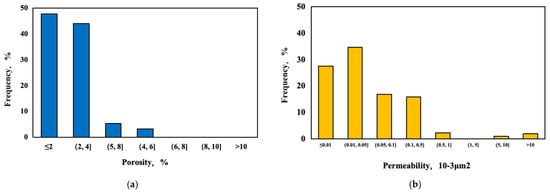
Figure 6.
Histogram of porosity and permeability distribution in the reservoirs of the study area. (a) Porosity; (b) permeability.
4.4. Pore Structure Characteristics of the Reservoir
The pore structure of a reservoir is a critical parameter for evaluating its hydrocarbon storage capacity and migration potential. Various characterization techniques are employed, often in combination, to comprehensively analyze pore types, sizes, distributions, connectivity, and evolutionary patterns. Among these methods, MICP testing has become widely adopted both domestically and internationally. MICP effectively characterizes the distribution of medium to large pores and pore throats in tight reservoirs through analysis of mercury intrusion curves and related parameters such as skewness, sorting coefficient, median radius, and displacement pressure [20,21].
As shown in Figure 7, MICP experiments conducted on 17 samples from the Bozi–Dabei area reveal that displacement pressures range from 1.66 to 18.49 MPa, with an average of 3.16 MPa. The maximum pore-throat radius of the reservoir matrix ranges from 0.15 to 3.68 μm, with an average of 0.60 μm, while the average pore-throat radius typically falls between 0.17 and 1.13 μm, averaging 0.41 μm. Overall, the Baxigai Formation in the Bozi area is characterized by medium–fine pores and micro-throats, with moderate displacement pressures. Notably, a comparison of MICP results between sandstone and conglomeratic sandstone samples shows distinct differences in pore-throat connectivity contributions. Sandstone samples typically exhibit unimodal and narrow pore-throat distributions, with flow capacity mainly contributed by throats and micropores. In contrast, conglomeratic sandstone samples display bimodal or multimodal broad peaks, with flow capacity being primarily controlled by larger pores. Furthermore, an increase in gravel content leads to significant variation in the pore-throat radius ratio, with conglomeratic reservoirs showing wider distributions and higher ratios. This observation highlights the strong sedimentary heterogeneity in grain size as a key factor driving the variability in pore-throat structures.
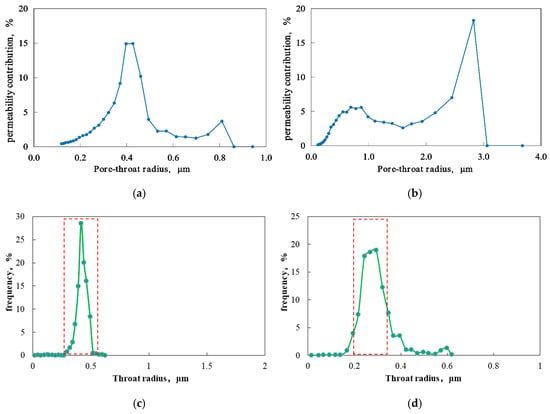
Figure 7.
Pore size distribution in Baxigai Formation. (a) BZ1203, 6666.6 m, sandstone; (b) BZ1501, 4972.5 m, conglomerate; (c) BZ1203, 6666.6 m, sandstone; (d) BZ1501, 4972.5 m, conglomerate.
5. Reservoir Quality Control Factors
Reservoir quality, which governs hydrocarbon storage and flow capacity, follows the global tripartite control framework (deposition–diagenesis–tectonics) established in foreland basins [22]. In the Baxigai Formation, multi-scale assessment of these controls is critical for exploration and development [23,24,25]. The reservoir quality of the Baxigai Formation in the study area is primarily governed by a combination of depositional processes, diagenetic transformations, and structural modifications. Among these, sedimentation controls the regional distribution pattern of high-quality reservoirs and provides the material basis for their development. Diagenesis plays a crucial role in determining the ultimate preservation and evolution of these reservoirs. Structural processes, particularly the formation of tectonic fractures, reactivation of early pore systems, and enhancement of fluid migration pathways, significantly improve the storage and permeability capabilities of the reservoirs.
5.1. Depositional and Compaction Controls
The Baxigai reservoirs in Bozi–Dabei feature a fan-delta system with dual provenance (South Tianshan and Wensu), developing microfacies including subaqueous distributary channels, interdistributary bays, sheet sands, and mouth bars. Statistical analysis reveals that medium-grained sandstones (0.25–0.5 mm) in the Kelasu fault zone exhibit optimal pore-throat configurations, yielding the highest porosity and permeability [26]. Fine-grained sandstones show intermediate properties, whereas coarse-grained variants suffer reduced quality due to intense compaction and cementation. Muddy pebbly medium sandstones display the poorest performance, with complex pore structures and severely impaired flow capacity (Figure 8).
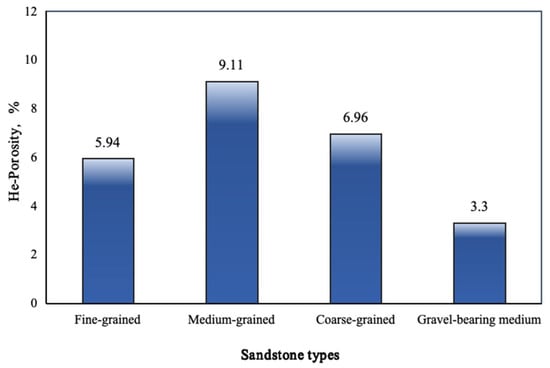
Figure 8.
Quantitative relationships between the reservoir physical properties and lithology of the Baxigai Formation in the Bozi–Dabei area, Kuqa Depression.
Compaction is a key diagenetic process that accompanies the entire burial evolution of a reservoir and plays a critical role in controlling reservoir physical properties [27,28]. Located within the foreland thrust belt of the Tarim Basin, the Bozi–Dabei area experiences intense compressional stresses, creating a typical strong compression tectonic regime. The Baxigai Formation in the study area is primarily composed of lithic arkose, lithic sandstone, and feldspathic litharenite. These rocks contain abundant soft lithic fragments (mainly phyllite and argillaceous rocks), which are highly plastic and prone to plastic deformation under compaction, leading to a rapid reduction in porosity (Figure 9a,b). Compaction primarily occurs during the early and middle diagenetic stages, with the effect being more pronounced during the middle stage, ultimately transforming reservoirs into low-porosity, low-permeability systems.
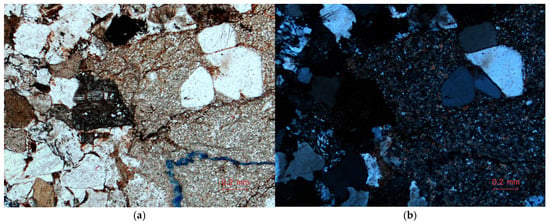
Figure 9.
Morphology and distribution of ductile lithic fragments. (a) Plane-polarized light; (b) cross-polarized light.
5.2. Diagenetic Controls on Reservoir Quality
Formation reservoirs in the Bozi–Dabei area have undergone multiple diagenetic processes, including mechanical compaction, calcite cementation, and lithic fragment dissolution. These processes have not only shaped the current state of the reservoir but also revealed its complex history of formation and evolution. The classification of diagenetic stages is primarily based on five parameters: (1) authigenic mineral assemblages, distribution, evolution, and formation temperatures; (2) organic matter thermal maturity; (3) mineralogical changes and types of cement; (4) fluid inclusion homogenization temperatures; (5) pore structure evolution and grain contact relationships. XRD analysis reveals that clay minerals indicate that illite is the dominant phase, followed by mixed illite–smectite layers and chlorite, while kaolinite and smectite are present in minor amounts. Fibrous and platy illite textures are observed, along with signs of analcime dissolution and iron-rich carbonate cementation. These features suggest that the samples are primarily in the middle diagenetic stage. Grain contacts are predominantly point–line to concave–convex, with local sutured contacts indicating moderate-to-strong compaction. Dissolution pores and microfractures dominate the pore systems, suggesting Mesodiagenetic Stage B attainment. The reconstructed diagenetic evolution sequence is shown in Figure 10.
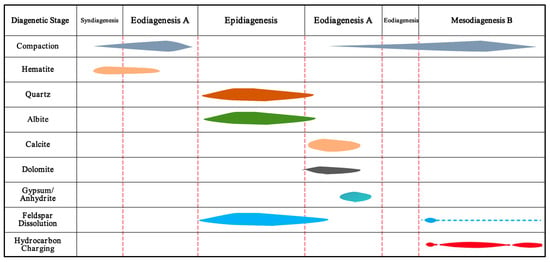
Figure 10.
Schematic diagram of the diagenetic evolution sequence of the Baxigai Formation in the Bozi–Dabei area, Kuqa Depression.
The Baxigai Formation experienced intense compaction and cementation, resulting in a pronounced pore evolution process. During the early burial stage (Diagenetic Stage A), the reservoir rocks were weakly to partially consolidated, with primary intergranular pores as the dominant pore type. Increasing burial depth and overburden pressure drove intense mechanical compaction, rapidly reducing porosity as the dominant process. Due to limited water–rock interaction, authigenic mineral development was weak, with only minor occurrences of early-stage hematite and calcite cementation observed locally. As the system transitioned from eogenetic to Early Diagenetic Stage B, compaction continued, and grain contacts evolved into linear and sutured forms, resulting in a more compact pore structure. Enhanced mineral–fluid interactions precipitated abundant authigenic quartz overgrowths, albite, calcite, and dolomite cements. In some zones, secondary dissolution pores developed due to early feldspar dissolution and organic acid reactions, leading to localized improvements in porosity and permeability. During Mesodiagenesis A to B, the reservoir entered a densification phase, with porosity generally falling below 10%. At this stage, synergistic compaction–cementation drastically reduced pore throats, closing most primary pores. Illite and mixed-layer clays dominated, with gypsum/anhydrite filling fractures and pores locally. Within this closed diagenetic system, cementation prevailed, slowing porosity reduction. Effective porosity comprised relict dissolution pores and fractures, marking the critical stage for developing fracture-enhanced tight reservoirs.
5.3. Impact of Tectonic Fractures on Reservoir Properties
Microfractures induced by tectonic deformation play a critical role in enhancing gas accumulation, improving reservoir quality, reshaping storage–flow systems, and controlling productivity distribution. Fracture networks effectively connect isolated dissolution pores, forming a dual-porosity and dual-permeability system comprising both pores and fractures. Logging imaging and core analysis indicate that high-angle tectonic fractures are extensively opened due to tectonic activity and further enhanced by late-stage fluid migration and organic matter evolution [29].
The study area has undergone multiphase tectonism, resulting in numerous NE-trending thrust faults that form favorable structural traps for hydrocarbons. The Bozi–Dabei area is primarily influenced by tectonic activity from the northern Tianshan orogenic belt, with multiple sets of NE-trending faults. Based on their vertical extent, the faults are classified into four levels (I–IV); Level IV faults are confined within the Baxigai Formation, while the others cut through the entire formation. Drilling data reveal that fractures are most developed near faults within the Baxigai Formation. Plan-view analysis shows that fractures predominantly trend N-S, NNE, and NNW, aligning closely with the orientation of major controlling faults. Fractures trending NWW and E-W are rare.
Deep burial (>6000 m) subjected reservoirs to intense compaction–cementation, resulting in low intrinsic permeability. As shown in Figure 11, average fracture porosity and permeability in the Bozi area are 0.055% and 39.88 × 10−3 μm2, respectively, while in the Dabei area, they are 0.023% and 25.16 × 10−3 μm2. As for structural microscale fractures, identified through methods such as core observation and image logging recording, average microfracture porosity and permeability are 0.129% and 0.21 × 10−3 μm2, respectively, in the Bozi area and 0.061% and 0.07 × 10−3 μm2 in the Dabei area. Tectonic fractures often pass through grains and connect adjacent pores. Under the influence of dissolution, they evolve into reticulated penetrative dissolution fractures (Figure 5c), significantly enhancing reservoir fluid conductivity. Therefore, macrofractures serve as primary flow conduits, while microfractures critically enhance permeability to establish fracture–pore reservoir systems.
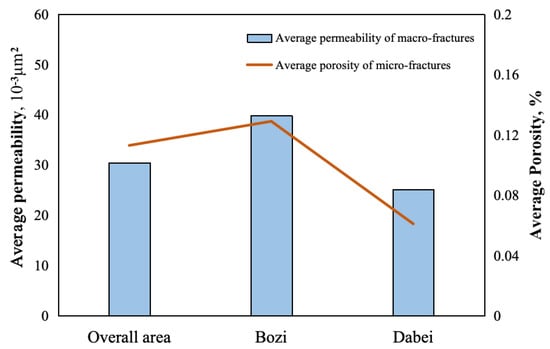
Figure 11.
Macro and micro physical properties of fractures in the study area.
5.4. Further Discussion
A comprehensive understanding of the geological architecture of a hydrocarbon-bearing basin and the identification of optimal exploration targets within the basin remain highly challenging tasks [30,31,32]. The present study aims to clarify and reveal the microscopic reservoir structure and controlling factors of the Baxigai Formation in the Kuqa Depression. It should be noted that our study is based on a relatively limited number of core and petrophysical samples, which may not fully capture the significant lateral heterogeneity of the Baxigai Formation in the Bozi–Dabei area. This limitation should be taken into account when interpreting the results, and future research should incorporate a broader and more diverse dataset to improve the statistical representativeness of reservoir characterization. Despite these limitations, the findings of this study, derived from a valuable suite of well exploration data, provide a first-order framework for understanding the reservoir architecture and controlling factors in this ultradeep foreland basin, which may support the identification of optimal locations for detailed exploration within the basin.
6. Conclusions
Based on a deep analysis of the evolution, characteristics, and controlling factors of the Baxigai Formation reservoirs in the Bozi–Dabei area, the following conclusions are drawn:
- (1)
- Within the typical foreland basin setting, the Baxigai Formation developed in a subaqueous braided river delta front environment, characterized by dual provenance from the South Tianshan Mountains and the Wensu paleo-uplift. Four sedimentary microfacies are identified: mouth bars, sheet sands, underwater distributary channels, and interdistributary bays, with widespread mudstone-wrapped sand bodies.
- (2)
- The Baxigai reservoirs are primarily composed of medium- to fine-grained sandstones, with high quartz and feldspar contents, reflecting a provenance partially derived from metamorphic rocks. Low compositional maturity (index = 0.5–0.9) and calcite/clay cements characterize the diagenetic framework. Primary pore systems include intergranular dissolution pores, intragranular dissolution pores, and macrofractures with minor microfractures. The reservoirs are classified as low-porosity and medium–low-permeability, with significant lateral heterogeneity. Fluid flow is mainly supported by throats and micropores.
- (3)
- Reservoir quality is jointly controlled by depositional microfacies, diagenesis, and structural fracturing. Subaqueous distributary channels and mouth bars provide favorable depositional conditions for reservoir formation. The dissolution of feldspars and reactions with organic acids promote the formation of intergranular dissolution pores, which are conducive to hydrocarbon generation and accumulation. Macroscopic fractures serve as primary migration pathways, while microfractures significantly enhance permeability and facilitate the formation of fracture–pore reservoirs.
Author Contributions
Conceptualization, F.Y., C.W., Y.L. and Y.X.; methodology, F.Y., C.W., K.Z., B.C. and S.X.; validation, F.Y., B.S. and C.W.; formal analysis, Z.J. and B.S.; investigation, Y.X. and S.X.; resources, F.Y.; writing—original draft, B.C.; writing—review and editing, F.Y. and Y.X.; Visualization, F.Y.; supervision, C.W., K.Z., B.S. and Y.L. All authors have read and agreed to the published version of the manuscript.
Funding
This work was funded by the Scientific Research Program Funded by Education Department of Shaanxi Provincial Government (Grant No. 23JS045), the Natural Science Basic Research Program of Shaanxi (Grant No. 2025JC-YBQN-739), and the Xi’an Science and Technology Plan Project (Grant No. 24GXFW0076).
Data Availability Statement
The data presented in this study are available upon request from the corresponding author. The data are not publicly available due to privacy restrictions.
Conflicts of Interest
Authors Fenglai Yang, Cuili Wang, Kun Zhou, Binghui Song, Yongqiang Xu, Yijia Li and Sa Xiao were employed by the PetroChina Tarim Oilfield Company. Also, author Fenglai Yang was employed by the China National Petroleum Corporation (CNPC). The remaining authors declare that the research was conducted in the absence of any commercial or financial relationships that could be construed as a potential conflict of interest.
References
- Neng, Y.; Qi, J.F.; Xie, H.W.; Li, Y.; Lei, G.L.; Wu, C. Structural characteristics of northern margin of Kuqa depression, Tarim Basin. Geol. Bull. China 2012, 31, 1510–1519. [Google Scholar]
- Wang, Q.; Xu, Z.; Zhang, R.; Yang, H.; Yang, X. New fields, new types of hydrocarbon explorations and their resource potentials in Tarim Basin. Acta Pet. Sin. 2024, 45, 15–32. [Google Scholar] [CrossRef]
- Jia, C.; Pang, X. Research processes and main development directions of deep hydrocarbon geological theories. Acta Pet. Sin. 2015, 36, 1457–1469. [Google Scholar] [CrossRef]
- He, D.F.; Li, D.S.; He, J.Y.; Wu, X. Comparison in petroleum geology between Kuqa depression and southwest depression in Tarim Basin and its exploration significance. Acta Pet. Sin. 2013, 34, 201–218. [Google Scholar] [CrossRef]
- Wang, Z.; Li, Y.; Xie, H.; Neng, Y. Geological understanding on the formation of large-scale ultra-deep oil-gas field in Kuqa foreland Basin. China Pet. Explor. 2016, 21, 37–43. [Google Scholar] [CrossRef]
- Jia, C.Z.; Zou, C.N.; Yang, Z.; Zhu, R.; Chen, Z.; Zhang, B.; Jiang, L. Significant progress of continental petroleum geology theory in basins of central and western China. Pet. Explor. Dev. 2018, 45, 546–560. [Google Scholar] [CrossRef]
- Jiang, X.; Shi, L.; Mo, T.; Yang, H.; Du, H.; Shi, W.; Dong, G. Characteristics and causes of physical property differences of deep and ultradeep tight sandstone reservoirs: A case study of the Bashijiqike Formation in the Bozi area of the Kuqa Depression. Bull. Geol. Sci. Technol. 2025, 44, 151–164. [Google Scholar] [CrossRef]
- Wang, K.; Zhang, R.H.; Zeng, Q.L.; Wang, J.P.; Xia, J.F.; Mo, T. Characteristics and formation mechanism of Lower Cretaceous deep and ultra-deep reservoir in Bozi-Dabei area, Kuqa Depression. J. China Univ. Min. Technol. 2022, 51, 311–328. [Google Scholar] [CrossRef]
- Zhang, G.J.; Zhang, B.X.; Xu, K.; Shen, C.B.; Zhang, H.; Yin, G.Q.; Wang, H.Y.; Wang, Z.M.; Liu, J.S. Fracture characteristics of ultra-deep tight sandstone reservoirs in the Bozi Block, Kuqa Depression of Tarim Basin, and effects on oil-gas production. Bull. Geol. Sci. Technol. 2024, 43, 75–86. [Google Scholar] [CrossRef]
- Wang, B.; Qiu, N.; Amberg, S.; Duan, Y.; Littke, R. Modelling of pore pressure evolution in a compressional tectonic setting: The Kuqa Depression. Tarim Basin, northwestern China. Mar. Pet. Geol. 2022, 146, 105936. [Google Scholar] [CrossRef]
- Wen, C.; Wang, Z. Formation and Evolution of Multi-Genetic Overpressure and Its Effect on Hydrocarbon Accumulation in the Dabei Area, Kuqa Depression, Tarim Basin, China. Energies 2024, 17, 6263. [Google Scholar] [CrossRef]
- Yang, K.; Xu, L.; Qi, J.; He, P.; Du, J.; Sun, T. Structural deformation of the northern Monocline Belt in the Kuqa Depression and implications for the Cenozoic uplift history of the South Tianshan Mountains. Tectonophysics 2023, 857, 229840. [Google Scholar] [CrossRef]
- Zeng, Q.; Mo, T.; Zhao, J.; Tang, Y.; Zhang, R.; Xia, J.; Hu, C.; Shi, L. Characteristics, genetic mechanism and oil & gas exploration significance of high-quality sandstone reservoirs deeper than 7000 m: A case study of the Bashijiqike Formation of Lower Cretaceous in the Kuqa Depression. Nat. Gas Ind. 2020, 40, 38–47. [Google Scholar] [CrossRef]
- Morton, A.C.; Hallsworth, C. Identifying provenance-specific features of detrital heavy mineral assemblages in sandstones. Sediment. Geol. 1994, 90, 241–256. [Google Scholar] [CrossRef]
- Mange, M.A.; Maurer, H. Heavy Minerals in Colour; Springer Science & Business Media: Berlin/Heidelberg, Germany, 2012. [Google Scholar]
- Liu, Q.; Zhu, H.; Shu, Y.; Zhu, X.; Yang, X.; Chen, L.; Tan, M.; Geng, M. Provenance identification and sedimentary analysis of the beach and bar systems in the Palaeogene of the Enping Sag, Pearl River Mouth Basin, South China Sea. Mar. Pet. Geol. 2016, 70, 251–272. [Google Scholar] [CrossRef]
- Morton, A.C.; Hallsworth, C.R. Processes controlling the composition of heavy mineral assemblages in sandstones. Sediment. Geol. 1999, 124, 3–29. [Google Scholar] [CrossRef]
- Wang, Q.; Yang, H.; Xu, Z.; Yang, X.; Li, Y.; Cai, Z.; Zhou, L. Major breakthrough and exploration significance of Well Ketan 1 in Kuqa depression, Tarim Basin. China Pet. Explor. 2023, 28, 1–10. [Google Scholar] [CrossRef]
- Huang, S.-Y.; Yang, W.-J.; Lu, Y.-H.; Zhang, K.; Zhao, Q.; Fan, S. Geological conditions, resource potential and exploration direction of natural gas in Tarim Basin. Nat. Gas Geosci. 2018, 29, 1497–1505. [Google Scholar] [CrossRef]
- Li, S.; Ma, L.; Wang, R.; Deng, J.; Li, Y.; Quan, X.; Jiang, R. Main controlling factors and development model of tight reservoirs in the Shihezi Formation Shanxi Formation in the Ordos Basin: Taking the Binchang area as an example. Bull. Geol. Sci. Technol. 2024, 43, 28–40. [Google Scholar] [CrossRef]
- Tang, Y.; Yang, X.; Xie, H.; Xu, Z.; Wei, H.; Xie, Y. Tight gas reservoir characteristics and exploration potential of Jurassic Ahe Formation in Kuqa depression, Tarim Basin. China Pet. Explor. 2021, 26, 113–124. [Google Scholar] [CrossRef]
- El-Ghali, M.A.; Shelukhina, O.; Abbasi, I.A.; Moustafa, M.S.; Hersi, O.S.; Siddiqui, N.A.; Al-Ramadan, K.; Alqubalee, A.; Bello, A.M.; Amao, A.O. Depositional and sequence stratigraphic controls on diagenesis in the Upper Cambrian-Lower Ordovician Barik Formation, central Oman: Implications for prediction of reservoir porosity in a hybrid-energy delta system. Mar. Pet. Geol. 2024, 160, 106611. [Google Scholar] [CrossRef]
- Yao, J.; Liu, X.; Zhao, H.; Li, X. Characteristics of He 8th member tight sandstone gas reservoir and solution based on geology-engineering integration in Ordos Basin. China Pet. Explor. 2019, 24, 186–195. [Google Scholar] [CrossRef]
- He, J.; Yang, Y.; Chen, W.; Xia, M.; Jia, S.; He, K.; Zhang, Y.; Liu, Y. Characteristics and main controlling factors for narrow channel tight sandstone reservoir: A case study of Shaximiao Formation in Jinhua Block of Tianfu Gas Field. Fault-Block Oil Gas Field 2024, 31, 1–10. [Google Scholar]
- Li, Y.; Sima, L.Q.; Yan, J.P.; Yang, L. Determination of petrophysical property cutoffs of tight sandstone gas reservoirs: A case study of T3x2 gas reservoirs in P area of central Sichuan Basin. Nat. Gas Ind. 2014, 34, 52–56. [Google Scholar] [CrossRef]
- Zhu, G.Y.; Zhang, S.C.; Zhang, B.; Su, J.; Yang, D.B. Reservoir types of marine carbonates and their accumulation model in western and central China. Acta Pet. Sin. 2010, 31, 871–878. [Google Scholar] [CrossRef]
- Shen, B.K.; Hu, Y.L.; Tian, C.B.; Xue, P.H.; Zhang, A.Q.; Li, G.C.; Xue, D.W. Fracture development in terrestrial glutinite reservoir: Taking the Lower Wuerhe Formation reservoirs in 8th district of Karmay Oilfield, NW China, as an example. Pet. Explor. Dev. 2005, 32, 41–44. [Google Scholar]
- Wang, B.; Qiu, N.; Wang, X.; Zhang, H.; Liu, Y.; Chang, J.; Zhu, C. Identification and calculation of tectonic compression overpressure of Kelasu-Yiqikelike Tectonic Belt in Kuqa Depression. Acta Pet. Sin. 2022, 43, 1107–1121. [Google Scholar]
- Wang, Z.M.; Wang, C.L.; Xu, K.; Zhang, H.; Chen, N.D.; Deng, H.C.; Hu, X.F.; Yang, Y.Y.; Feng, X.L.; Du, Y.; et al. Characteristics and controlling factors of tectonic fractures of ultra-deep tight sandstone: Case study of the Lower Cretaceous reservoir in Bozi-Dabei area, Kuqa Depression, Tarim Basin. Nat. Gas Geosci. 2023, 34, 1535–1551. [Google Scholar] [CrossRef]
- Shanley, K.W.; Cluff, R.M.; Robinson, J.W. Factors controlling prolific gas production from low-permeability sandstone reservoirs: Implications for resource assessment, prospect development, and risk analysis. AAPG Bull. 2004, 88, 1083–1121. [Google Scholar] [CrossRef]
- Gangrade, R.; Grasmick, J.; Trainor-Guitton, W.; Mooney, M. Risk-based methodology to optimize geotechnical site investigations in tunnel projects. Tunn. Undergr. Space Technol. 2022, 127, 104589. [Google Scholar] [CrossRef]
- Liu, K.; Wang, R.; Shi, W.; Travé, A.; Martín-Martín, J.D.; Baqués, V.; Qi, R.; Lin, J.; Ye, H. Diagenetic controls on reservoir quality and heterogeneity of the Triassic Chang 8 tight sandstones in the Binchang area (Ordos Basin, China). Mar. Pet. Geol. 2022, 146, 105974. [Google Scholar] [CrossRef]
Disclaimer/Publisher’s Note: The statements, opinions and data contained in all publications are solely those of the individual author(s) and contributor(s) and not of MDPI and/or the editor(s). MDPI and/or the editor(s) disclaim responsibility for any injury to people or property resulting from any ideas, methods, instructions or products referred to in the content. |
© 2025 by the authors. Licensee MDPI, Basel, Switzerland. This article is an open access article distributed under the terms and conditions of the Creative Commons Attribution (CC BY) license (https://creativecommons.org/licenses/by/4.0/).